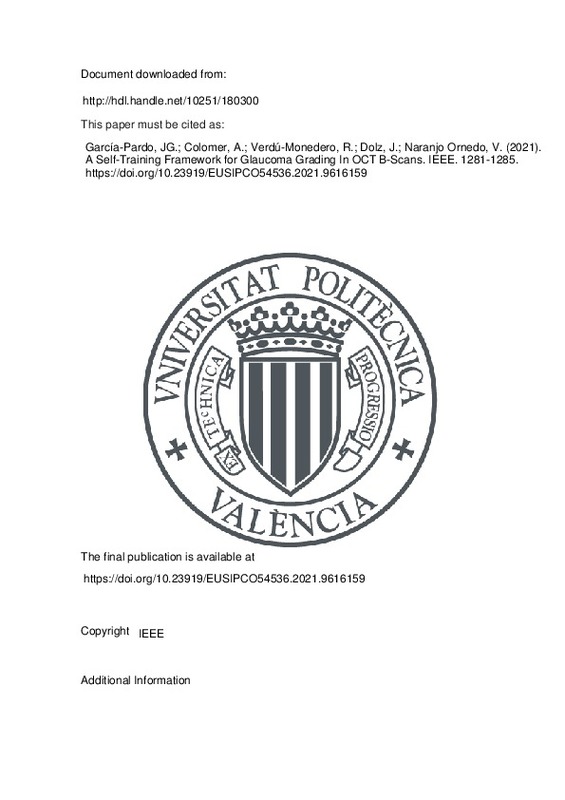JavaScript is disabled for your browser. Some features of this site may not work without it.
Buscar en RiuNet
Listar
Mi cuenta
Estadísticas
Ayuda RiuNet
Admin. UPV
A Self-Training Framework for Glaucoma Grading In OCT B-Scans
Mostrar el registro sencillo del ítem
Ficheros en el ítem
| dc.contributor.author | García-Pardo, José Gabriel
|
es_ES |
| dc.contributor.author | Colomer, Adrián
|
es_ES |
| dc.contributor.author | Verdú-Monedero, Rafael
|
es_ES |
| dc.contributor.author | Dolz, Jose
|
es_ES |
| dc.contributor.author | Naranjo Ornedo, Valeriana
|
es_ES |
| dc.date.accessioned | 2022-01-28T06:54:15Z | |
| dc.date.available | 2022-01-28T06:54:15Z | |
| dc.date.issued | 2021-08-27 | es_ES |
| dc.identifier.isbn | 978-9-0827-9706-0 | es_ES |
| dc.identifier.uri | http://hdl.handle.net/10251/180300 | |
| dc.description.abstract | [EN] In this paper, we present a self-training-based framework for glaucoma grading using OCT B-scans under the presence of domain shift. Particularly, the proposed two-step learning methodology resorts to pseudo-labels generated during the first step to augment the training dataset on the target domain, which is then used to train the final target model. This allows transferring knowledge-domain from the unlabeled data. Additionally, we propose a novel glaucoma-specific backbone which introduces residual and attention modules via skip-connections to refine the embedding features of the latent space. By doing this, our model is capable of improving state-of-the-art from a quantitative and interpretability perspective. The reported results demonstrate that the proposed learning strategy can boost the performance of the model on the target dataset without incurring in additional annotation steps, by using only labels from the source examples. Our model consistently outperforms the baseline by 1¿3% across different metrics and bridges the gap with respect to training the model on the labeled target data. | es_ES |
| dc.description.sponsorship | We gratefully acknowledge the support of the Generalitat Valenciana (GVA) for the donation of the DGX A100 used for this work, action co-financed by the European Union through the Programa Operativo del Fondo Europeo de Desarrollo Regional (FEDER) de la Comunitat Valenciana 2014-2020 (IDIFEDER/2020/030). | es_ES |
| dc.language | Inglés | es_ES |
| dc.publisher | IEEE | es_ES |
| dc.relation.ispartof | 29th European Signal Processing Conference (EUSIPCO 2021). Proceedings | es_ES |
| dc.rights | Reserva de todos los derechos | es_ES |
| dc.subject | Glaucoma grading | es_ES |
| dc.subject | Self-training | es_ES |
| dc.subject | OCT | es_ES |
| dc.subject.classification | TEORIA DE LA SEÑAL Y COMUNICACIONES | es_ES |
| dc.title | A Self-Training Framework for Glaucoma Grading In OCT B-Scans | es_ES |
| dc.type | Comunicación en congreso | es_ES |
| dc.type | Capítulo de libro | es_ES |
| dc.identifier.doi | 10.23919/EUSIPCO54536.2021.9616159 | es_ES |
| dc.relation.projectID | info:eu-repo/grantAgreement/EC/H2020/732613/EU/ | es_ES |
| dc.relation.projectID | info:eu-repo/grantAgreement/GVA//IDIFEDER%2F2020%2F030/ | es_ES |
| dc.relation.projectID | info:eu-repo/grantAgreement///PTA2017-14610-I//AYUDA TECNICO DE APOYO MINISTERIO-GARCIA PARDO/ | es_ES |
| dc.rights.accessRights | Abierto | es_ES |
| dc.contributor.affiliation | Universitat Politècnica de València. Departamento de Comunicaciones - Departament de Comunicacions | es_ES |
| dc.description.bibliographicCitation | García-Pardo, JG.; Colomer, A.; Verdú-Monedero, R.; Dolz, J.; Naranjo Ornedo, V. (2021). A Self-Training Framework for Glaucoma Grading In OCT B-Scans. IEEE. 1281-1285. https://doi.org/10.23919/EUSIPCO54536.2021.9616159 | es_ES |
| dc.description.accrualMethod | S | es_ES |
| dc.relation.conferencename | 29th European Signal Processing Conference (EUSIPCO 2021) | es_ES |
| dc.relation.conferencedate | Agosto 23-27,2021 | es_ES |
| dc.relation.conferenceplace | Online | es_ES |
| dc.relation.publisherversion | https://doi.org/10.23919/EUSIPCO54536.2021.9616159 | es_ES |
| dc.description.upvformatpinicio | 1281 | es_ES |
| dc.description.upvformatpfin | 1285 | es_ES |
| dc.type.version | info:eu-repo/semantics/publishedVersion | es_ES |
| dc.relation.pasarela | S\445151 | es_ES |
| dc.contributor.funder | Generalitat Valenciana | es_ES |
| dc.contributor.funder | European Regional Development Fund | es_ES |







![[Cerrado]](/themes/UPV/images/candado.png)

